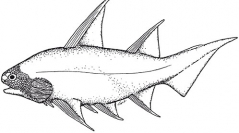

 Geodiversitas
30 (2) - Pages 303-330
Geodiversitas
30 (2) - Pages 303-330Gladiobranchus probaton Bernacsek & Dineley, 1977 was described based on poorly preserved specimens, and originally assigned to the Ischnacanthiformes because of its resemblance to Uraniacanthus spinosus Miles, 1973. Incomplete fossils of G. probaton which were available to Bernacsek and Dineley for the original species description, lacked teeth and/or dentigerous jaw bones and until now, the classification and relationships of G. probaton remained unresolved. New, nearly complete specimens show details of the rostrum, jaws, and the complete caudal fin, and correct some errors in the original species description. The toothless jaws, the enlarged anterior and posterior circumorbital plates, elongate, deeply inserted dorsal fin-spines, the structure of the scapulocoracoid, and the prepelvic fin-spine complement all indicate that G. probaton is a diplacanthoid, and not closely related to ischnacanthid acanthodians. Re-examination of U. spinosus shows that there are no dentigerous jaws with any body fossils, and the striking similarity of U. spinosus and G. probaton suggest that both should be placed in the same diplacanthoid family, Gladiobranchidae.
Gladiobranchus, Uraniacanthus, Acanthodii, taxonomy, diplacanthids, systematics